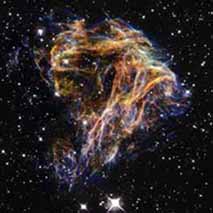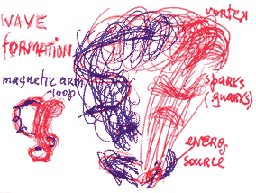Asexual Reproduction
(Continued —
Page 3)
Over the course of several eons, magnetic gravitational stars
constantly lose energy and gradually shrink, until they eventually
blow up and assume a new form — a new life formation
(picture and attendant illustration below). The energy that
is released proceeds to create new, two-loop formations. Thereafter,
the gravitational star (loop) forges two types of energetic
matter, with the energetic-electric loop located below and
a new galaxy-like, magnetic formation above:
 
Both swirls are concentrated within the magnetic
star. Following the explosion, the balance of energy between
the two loops changes. Energetic loops that are similar to
the original loop suddenly appear. Only energetic matter can
generate a new life cycle from an old formation. This is indeed
one of the true wonders of nature. The energetic swirl is
younger and more prominent while the older swirl is more magnetic,
but both properties undergo changes during the lifetime of
every energetic formation. The magnetic star thus serves as
yet another example of the fact that all formations are composed
of two types of energetic matter (swirls).
The magnetic loop, which shares a striking resemblance
to the female ovum, is extremely resilient. It can survive
for years despite the fact that it perpetually loses energy.
The magnetic loop protects all its "genes" from
the energetic wave. In contrast, the highly energetic sperm
(the male loop), which corresponds to the energetic-electric
loop, has a very short lifespan. Nature is cognizant of its
inability to preserve the energetic loop, so it concentrates
on protecting the magnetic loop, which waits for the opportunity
to acquire an "energetic loop" in order to complete
the wave formation.
The energy for the second loop may derive from
many sources. For example, female lizards, which are considered
to be asexual, generate heat by rubbing up against each other
and thus form an "energetic loop." The resultant
energy then causes the egg to divide. Many life forms engender
their energetic loops by taking advantage of the energy in
their vicinity, such as the Sun. Fledglings are similarly
nurtured by the energy from their brooding mother's heat.
Furthermore, some organisms, such as flowers and fungus, propagate
by forming multiple "magnetic" loop-like structures
in which they store and disseminate their original formation,
while waiting for energy to arrive from other sources. In
all these organisms, the energy that is secured serves as
the energetic loop and causes the magnetic loop to divide.
The asexual method of reproduction is more prevalent
than the sexual method due to its ability to survive under
adverse conditions for extended periods. In contrast, the
progeny of sexual reproduction tend to be more energetic and
expand over large areas. Moreover, they exhibit a much higher
level of creativity and procreate quicker. However, they are
more susceptible to drastic changes in the climate and are
weaker than their resilient non-sexual counterparts.
Back to Top
Dr. Chaim Tejman, Copyright©
2004. All rights reserved.
[Index]
[Introduction]
[Summary] [Book]
[Wave Formation] [Photons]
[Gravitation] [Time]
[Atoms] [Life]
[Cancer] [Fundamental
Force] [Gender/Why Sex?]
[Creation] [Supernova]
[Dark
Matter & Astronomy] [Speed
of Light] [Cloud Formations]
[Natural Disasters] [Global
Warming] [Thermodynamics]
[Backward Time] [Quantum
Mechanics] [Compton Effect]
[Equations] [Predictions]
[Academic Correspondences] [Contact]
[Links] [Mysteries] |